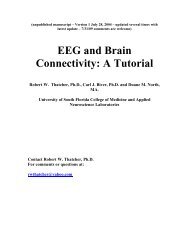Clinician's Guide - Bio-Medical Instruments, Inc.
Clinician's Guide - Bio-Medical Instruments, Inc.
Clinician's Guide - Bio-Medical Instruments, Inc.
You also want an ePaper? Increase the reach of your titles
YUMPU automatically turns print PDFs into web optimized ePapers that Google loves.
2. Thompson Screens: PI MT 1EEG-Physio … channel sets: These channel sets are<br />
described in this guide. These channel sets have used all the virtual channels available in<br />
this program in order to give the practitioner the maximum degrees of freedom in<br />
choosing band-widths for feedback in conjunction with sensors for BFB. These channel<br />
sets allow you to do both assessments and feedback. These uses will be described below.<br />
We have attempted to take into consideration the common uses for NFB. As a NFB /<br />
BFB ‘generalist’ clinician you will most often be seeing:<br />
i. Children or Adults<br />
• ADHD (+ Asperger’s or + Seizure Disorder)<br />
• ADD (+ LD)<br />
These students do best if NFB is combined with metacognition<br />
ii. Adolescents & Adults<br />
• Ruminating, tense, anxious, + secondary inattention<br />
• Wish to Optimize Performance in academics, business and sports<br />
These clients all require cognitive strategies to assure that training ‘generalizes’<br />
to their every-day environment.<br />
The MT channel sets have taken into account the goals for training and matched them to<br />
the most common bandwidths and BFB modalities that are used for feedback (training)<br />
1 ST . Children or Adults (Below are suggestions for Cz training)<br />
• ADHD (+ Asperger’s or + Seizure Disorder)<br />
Impulsivity<br />
Emotional lability<br />
Hyperactivity<br />
(‘Firewall’ for seizure disorder)<br />
Attention Span (external )<br />
Activate inactive area by decreasing<br />
dominant slow wave (e.g., sensory<br />
aprosodia activate P4, T6)<br />
• ADD (+ LD)<br />
Concentration<br />
Activate brain area required for task (e.g.,<br />
Wenicke’s area for reading comprehension)<br />
<strong>Inc</strong>rease Attention Span (external) and<br />
‘activate’ inactive area.<br />
↑ SMR 13-15 Hz<br />
or<br />
12-15 Hz or<br />
13-16 Hz<br />
Decrease dominant<br />
slow wave or<br />
abnormal fast wave<br />
↓ Low Theta 3-7<br />
↓ Theta 4-8<br />
↓ High Theta 5-7<br />
↓ Thalpha 6-10<br />
↓ Low Alpha 8-10<br />
↓ Hi-Beta<br />
↑ Problem solving<br />
beta: 15 – 18 Hz<br />
(perhaps 38-42 Hz)<br />
↓ Theta &/or<br />
↓ Low Alpha &/or<br />
↓ Hi-Beta<br />
These students all require that NFB be combined with metacognition<br />
Copyright ADD Centres Ltd. Prepublication – 1 st draft. Please do not copy. Dr. Thompson 905-803-8066 Canada 44
















